One of the things I have found fascinating as I’ve researched family history is the way that the evolving transportation methods affected and played into the function of everyday life. During my great-grandmother’s lifetime she saw the horse and buggy give way to the automobile much in the same way her parents experienced the landscape transformation brought on by the expansion of the railway.
Although I haven’t come across a concise memory or comment (yet) in my great-grandmother’s letters to hang this chapter on, I have found enough news and commentary pieces to pull together, what I hope, is an interesting chapter.
Let’s start with “manes” (aka horses) which were the primary mode of local transportation when May Northcutt, my great-grandmother, was born in 1880.
One of my favorite early photos of May (1880-1975) is this photo of her at the reins of the family’s “surrey-with-a-fringe-on-top” buggy. I believe that it was taken circa 1900 and the four other individuals in the buggy are May’s two sisters, Ray and Nell along with cousins, Lillie (daughter of A.D. Northcutt) and Bessie (daughter of J.C. Northcutt). The photo was taken in front of the family’s home, which appears to have been at the edge of the town’s development to that point, hence the end of elevated boardwalk sidewalks.
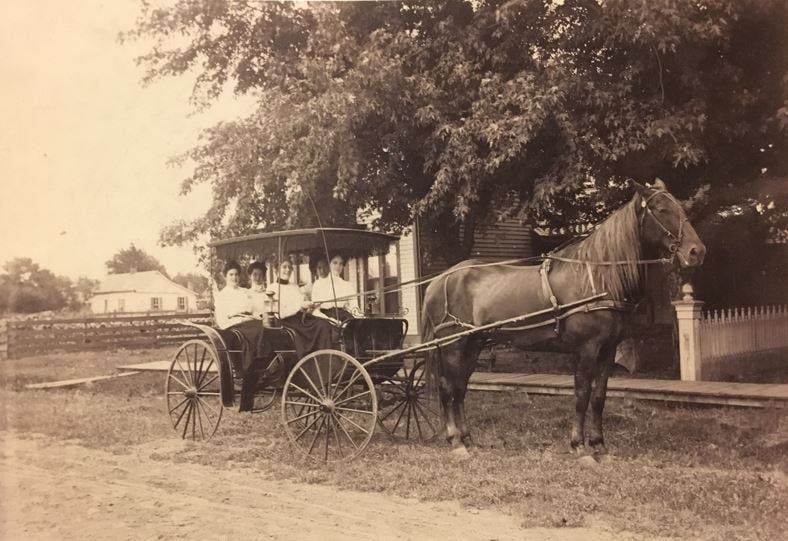
The family horse is an absolutely beautiful and massive equine. I’m guessing, the horse may have been bred at W.T. Mitchell’s farm which was located just 7 miles west of Knox City. Mitchell had quite a reputation for breeding very large work horses.
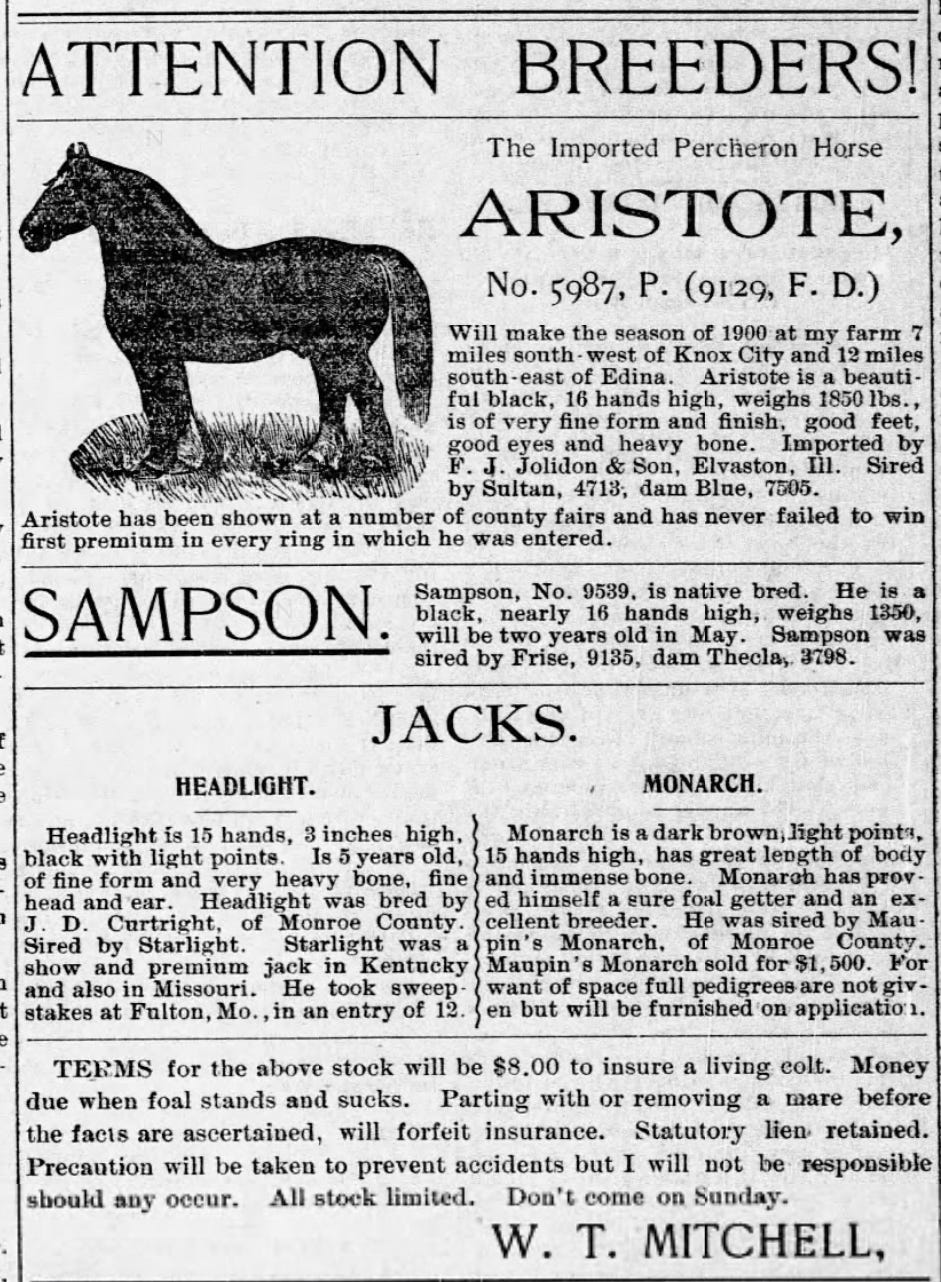
Horses were important to life and transportation in the 1800s and early 1900s. In fact, so much so that many cities and small towns had their own chapters of the Anti-Horse Thief Association (AHTA) that supported the capture and lawful prosecution of horse thieves in the court system.
The AHTA as a movement was actually started less than 30 miles from Knox City in the neighboring county of Clark. David McKee, a farmer and livestock rancher started the organization in 1854 to help combat the growing problem of horse and livestock theft across the state borders between Missouri, Iowa, and Illinois. The basic tenet of the organization was both to help support the protection of property (especially horses and livestock) and the lawful capture and conviction of thieves through the court system. AHTA was not a vigilantism organization. It functioned only to support the law and legal court system and was one of the reasons that the organization grew so quickly. With its motto “Protect the innocent, bring the guilty to justice”, it provided a way for law-abiding citizens to help combat what was a significant problem in many communities.
May’s father, J.R. Northcutt, helped organize the town’s local AHTA chapter in 1901. He was elected President of the group, which from what I can tell met occasionally whenever the need arose.

I’m not sure how long the AHTA Chapters in Knox City/ LaBelle organized and met. But these two news items from 1903 suggest that the group met regularly. Their organization also seems to have had some success, as reported in August 1903.
‘Driving’ a horse, much like driving a car, came with its own set of rules and risks. But I suspect that my great-grandmother was, for the most part, very comfortable behind the reins. For the first 40 years of May’s life the ‘horse and buggy’ provided her family with their main source of local transportation. From the large number of newsworthy notices I found in my LaBelle Star newspaper sleuthing, it seems the family buggy was used frequently to travel the five-mile distance to visit May’s parents in the neighboring town of Knox City. This small news item from 1905 shares that May experienced an accident while driving the family buggy into town. Fortunately, she was not hurt and survived with only bruises.
While horse and buggy provided the main source of transportation locally in small towns in the early 1900s, the railway system provided the means for the citizens of LaBelle and Knox City to visit St. Louis, Kansas City and the rest of the country.
Both LaBelle and Knox City were connected on the Quincy, Omaha, and Kansas City Railroad line in 1873. Locally known as the "OK Route", the railway was frequently traveled by both the Northcutt and Hinkson families east to Edina and west to Quincy (which is on the Mississippi river) for business and social purposes. But in the summer of 1902 May used the rail system for a much larger adventure… a trip to Colorado.
In the summer of 1902 May was back home in Knox City after her second year of teaching school in Moulton, Iowa. She was not the only ‘young teacher’ among the Knox City Northcutts that would be home that summer. Her sister Virginia Ray had just completed her first teaching assignment in the Musser district and cousin Lillie Lee completed her third year teaching at LaPlata, MO.
All three girls had graduated from the Kirksville Normal School in consecutive years. Lillie in 1899, May in 1900, and Virginia Ray in 1901. During the summer of 1902, these three young women (who were between the ages of 20-23) had a bit of earnings from their teaching jobs and a summer free from responsibilities. They were ready for a little adventure.
I’m guessing that the following advertisement that appeared in the LaBelle Star in the late spring of 1902 was the impetus for their Colorado adventure. It promised a multi-day rail tour tColorado for the low price of $15 - the rough equivalent of $550 in 2024 dollars.
From the following newspaper items that appeared in the LaBelle Star the summer of 1902 it is clear that number of local area residents took advantage of the trip. In total 19 local residents traveled together to form a “merry party” of adventurers. Here are the news items from the LaBelle Star chronicling their adventure.
It would be wonderful to have found a photo or two from the this great adventure that the three young cousins took together. But alas, I don’t think any exist. What I can share this photo of the three of them (that is part of a larger photo of Northcutt cousins) which is from the same time period.

The route they would have taken to get to Colorado is highlighted (in light green) in this Burlington Railroad map from 1902. It also shows the expansiveness of the just this railroad. In 1902, there were 67 different railway companies operating within the United States. The girls would have taken a “OK Route” railroad from Knox City to Kansas City to join the trip and I believe this was the first real sight-seeing vacation that any of the girls had ever experienced.
The popularization of the automobile in the 1910s significantly changed the landscape of towns and cities across the United States. Overnight new businesses seemed to open up to sell cars, provide fuel, and repair and maintain vehicles. By 1910, it was estimated that there were about 500,000 automobiles in the United States. By 1920 that number had grown to over 8 million registered owners as automobiles became more affordable and less of a luxury item.
May’s father was among the early adopters in Knox City to own an automobile. To him it was a necessary item, a so-called “Doctor’s servant” as he put it, that would assist him in providing quicker service to his patients. J.R. Northcutt purchased his Ford Touring car in the summer of 1914 for roughly $520 from a newly established Edina dealership. Sands-Smith Motor Company opened its first salesroom on January 15, 1914. May’s father purchased his Ford less than 6 month later.

While May’s father may have been among the earliest businessmen in the area to purchase a car, it would be five more years before May and her husband Tom would embark on such a large purchase.
In November 1919, the LaBelle Motor Company announced itself with a splashy full page newspaper ad (page 6) in the LaBelle Star for the new Overland Four. A smaller notice on the paper’s opposite page touted the “car is recognized as the cheapest car for the money on the market.”
Interest was very high among the LaBelle community. Sales of this new automobiles were popular and reported weekly in the newspaper. Tom and May purchased their Overland in July 1920. The published price at the time for the vehicle was $845.
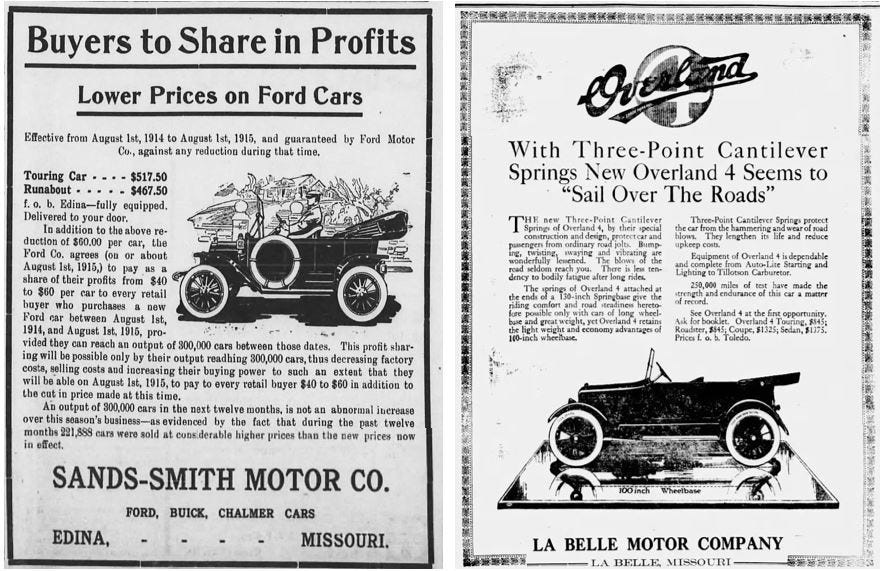
I find it interesting to research history like this, especially as it relates to genealogy. Before this project I had never heard of Overland as an automobile company. But it’s apparent that in 1920 it was a very well known manufacturer.
The Overland as a motor company began in 1903 and was originally headquartered in Toledo, Ohio. Like many young upstart motor companies of the early 1900s the Overland company had its share of issues including production and bankruptcy. But in 1908 things improved when the company was purchased by J. N. Willys and production moved to Indianapolis, IN. From 1912-1918 Overland was the second largest producer of automobiles in the US behind Ford. The company was apparently growing steadily until the depression of 1920 (caused by the start of WWI) brought the company to its knees. Throughout the 1920s and 1930s Overland-Willy continued to try to re-energize its line of cars, but it struggled. Its fate as a manufacturer was sealed with the start of WWII. At which time its manufacturing plants were reconfigured to build aircraft assemblies for Lockheed Hudson bombers. During the war, the company also supported the production of military jeeps. After the war they developed and marketed utility-type jeeps for the mainstream market under the Willy’s moniker. The company was sold in 1953 ending the era of the Overland-Willys automobile.
I’m not sure how long either the Ford that J.R. Northcutt bought or the Overland that the Hinksons owned lasted. But I do know that J.R. was gifted a new car by the Knox City community on his 86th birthday. I won’t go into the details here, but will save that remarkable story for a future chapter. 😊
To close out this chapter on the history of Northcutt Hinkson family transportation it seems fitting to highlight this recent letter in which May provides some details about her train ride from East Lansing, MI to San Francisco, CA in January 1964.
In the 1960s, when May was in her 80s, she would often close up her home in LaBelle for 2 to 3 months at a time and split her holiday time with her “three daughters”; Helen (my maternal grandmother) who lived in Michigan, Virginia, who lived in California, and Marie, who lived in St. Louis (technically Marie was her daughter-in-law, but May always called her a ‘daughter’). May typically traveled by train and bus for these visits - which were both modes of transportation with which she had a lifetime of experience.
In 1964 she was 84 years old as she embarked on a train trip from Michigan to California. I would love to know her thoughts on how the scenery of the western states, especially Kansas, Nebraska, and Colorado, were different from her trip across these same states in 1902. Alas, that’s not possible. But I am grateful that I have her letters for I’m finding they provide so many more clues and insights into my great-grandmother than I ever anticipated.
Letter #115. Postmarked from San Francisco January 9, 1964, Addressed Mrs. Douglas Green E., Lansing, MI .
Wednesday P.M.
Dear Helen,
It is almost 4 o’clock and soon George will be coming in, Virginia is getting her hair done before she comes home – the appointment was for yesterday, but she came to meet me instead. She drove by the depot on her way home from school and George came down on the bus. It was good to see them standing there. The trip was good, plenty of room on the train – the stations – both stations in Chicago were mad houses at times – an hour or so before trains left, but I survived, no trouble about my seat. Some people were quite mixed up and some just simply paid no attention to seat number.
Later, George and I had coffee and the noodles are ready to go in with the chicken breast – George is wondering if we should be doing anything else towards supper, but there were no directions left.
Such a fine time as I had in Lansing – your nice warm house is so pretty and you are a gracious hostess. I loved every minute of the time with you and your two lovely children. The household here got a card from them today, but it was written January 4 and there wasn’t much in it that hadn’t been told when you talked to them. I imagine they will be moving along by the end of the week or the first of next.
There – that was Virginia honking for George to come bring the car in. This morning I took the bath. I was too tired to take last night – we visited until very late – put up my hair and unpacked and got settled for my visit – I didn’t bother about lunch – ate an orange, took a nap, made the noodles and cooked the chicken and that was it. Now supper is on and TV is on.
Sunday morning when I got in Dearborn station it was crowded but soon some trains left and I got to the Santa Fe information desk and he sent me to someone else who said “let me see the transportation you have” he looked it over and said,“lady you better hold onto what you have”. I still wanted to try the other so he sent me onto the ticket window. The man there was very nice and didn’t lose his patience when I kept going back to see if there had been a cancellation. When I decided to give it up there was no railway transfer at that particular time, but the woman was nice and phoned for a bus at last it came and the driver wanted to know why I hadn’t gone over when the runs were on but at any rate I got over – eight at the standup place – and before too long it was train time and I was on my way. Your lunch was so good but I had lots left – no tangerines, they really hit the spot. I ate dinner Monday night in the diner just for the novelty of it – the most beautiful scenery I believe in the world is between Denver and on into California. The flat part of California isn’t pretty but after we got into the coast range, it was pretty again. They had a big rain Monday night – Virginia said it wasn’t a big rain just rain.
As soon as I get squared around and get my bearings, I’ll decide when I’ll go to Penny’s. After getting worked up to the idea of stopping there, I was quite disappointed when the plan didn’t materialize. It is sinful the way I love your girls.
The enclosed letters Virginia saved for me to read because I met the Housens when I was here five years ago – I thought maybe since you have a Thai friend you’d enjoy reading them – Virginia said, destroy them when you are through with them she isn’t keeping them. We will send you a Chinese New Year’s card. Virginia said one of the teachers will get one for her she is sure.
I get my letters to your friends who were so nice to me to be written soon. Now Virginia and I are going to go over the rest of her Christmas cards. She had left them up to go over again with me. We did part of them last night – I love you my child and thank you again for the lovely visit and the rest – everything! Mother [May Emma Northcutt Hinkson]
Addendum: May 2025
In my reading from a recent letter from 1967, I found this gem of comment that directly speaks to the extraordinary transportation advancements that my great-grandmother experienced in her life-time. This reflection came on the heals of visit by her granddaughter Jenny and husband Larry (my aunt and uncle). Larry, an Air Force pilot, flew the family to Edina in a small plane for a brief LaBelle visit in the summer of 1967. A treat for both family and grandmother:
“Jeanette1 let Larry take her car when they went to see Aunt Nelle and to see about refueling the plane. She met them and took them down yesterday morning. I went along and got in and out of the car very easily, if not too gracefully. It seems strange that I, a product of the horse and buggy age, should see my granddaughter gaily waving at me from a little plane up in the air. My short vision soon lost them, but Jeanette could see a tiny spec for several minutes. They are all three honeys and I was so glad to have them come visit me. That little boy couldn’t be nicer nor could his parents.”
Letter #288 Postmarked June 6, 1967
Jeanette McCracken was my great-grandmother’s neighbor. She had gone to school with my grandmother Helen and was like a second-daughter to May Hinkson.



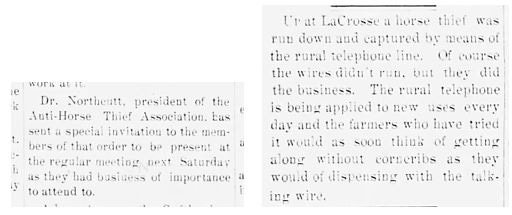
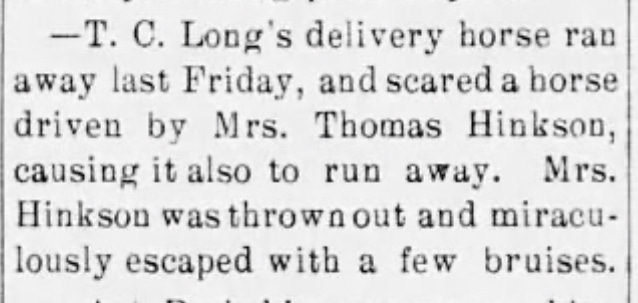



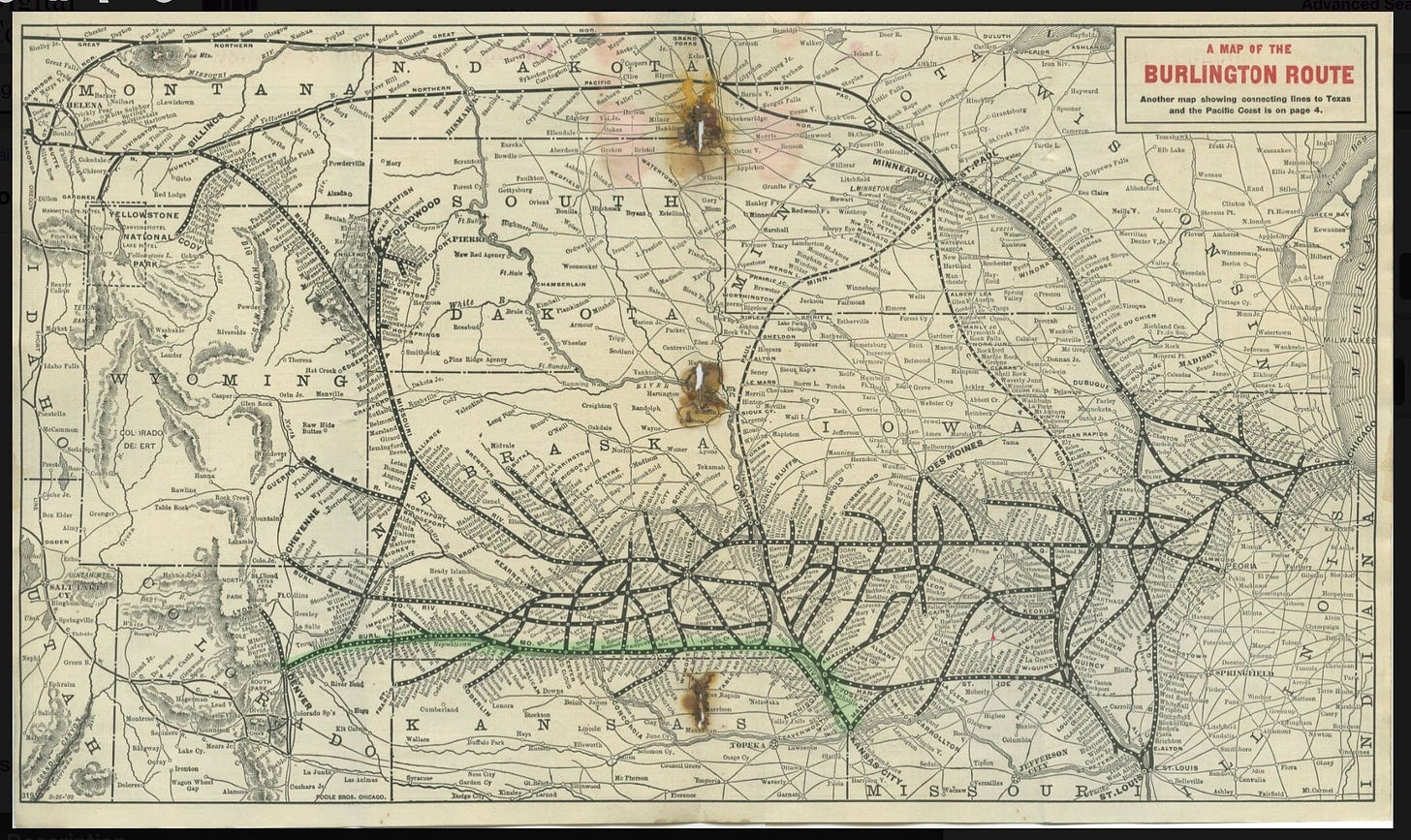






What a wonderful story, and so well researched! I especially enjoyed the details you found about the anti horse thief group and the advertisement for the Denver trip.
It’s always weird to think that our people witnessed those changes - from horse and buggy to cars — in a single lifetime, and we have their stories.